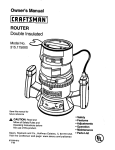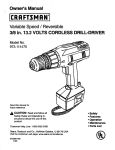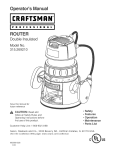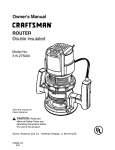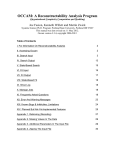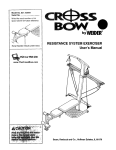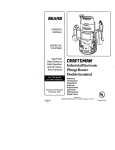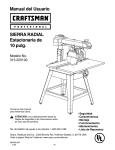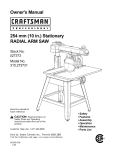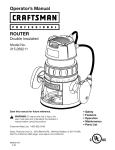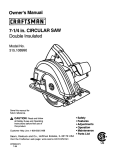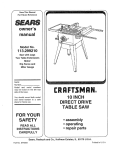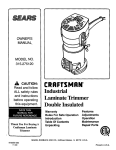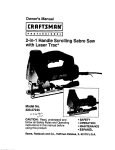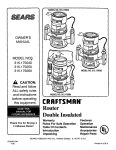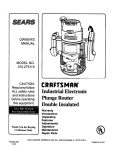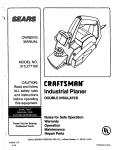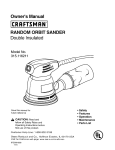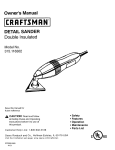Download Craftsman 315.17513 User's Manual
Transcript
Owner's Manual ROUTER Double Insulated Model No. 315.175130 Save this manual future reference CAUTION: for Read and follow all Safety Rules and Operating Instructions before first use of this product. Customer Help Line: 1-800-932-3188 Sears, Roebuck and Co., Hoffman Estates, IL 60179 USA Visit the Craftsman web page: www.sears.com/craftsman 972000-772 8-00 • • • • • • Safety Features Adjustments Operation Maintenance Parts List ® • Table Of Contents .......................................................................................................................................... 2 • Warranty ......................................................................................................................................................... 2 • Introduction ..................................................................................................................................................... 2 • Rules for Safe Operation ............................................................................................................................. 3-5 • Product Specifications • Unpacking ....................................................................................................................................................... 5 • Accessories .................................................................................................................................................... 5 • Features ......................................................................................................................................................... 6 • Adjustments ................................................................................................................................................. • Operation ................................................................................................................................................... • Maintenance • Exploded View and Repair Parts List ...................................................................................................... • Parts Ordering / Service ............................................................................................................................... .................................................................................................................................... ............................................................................................................................................ FULL ONE YEAR WARRANTY 5 7-9 9-13 14-15 16-17 18 ON rRRFTSMRN ROUTER If this rRRFT$14RN Router fails to give complete satisfaction within one year from the date of purchase, RETURN IT TO THE NEAREST SEARS STORE OR SEARS SERVICE CENTER IN THE UNITED STATES, and Sears will repair it, free of charge. If this rRRFT$14RN Router is used for commercial from the date of purchase. or rental purposes, this warranty applies for only 90 days This warranty gives you specific legal rights, and you may also have other rights which vary from state to state. Sears, Roebuck and Co., Dept. 817 WA, Hoffman Estates, IL 60179 Your router has many features for making routing operations more pleasant and enjoyable. Safety, performance and dependability have been given top priority in the design of this router making it easy to maintain and operate. _Look for this symbol safety is involved. _k to point out important _k CAUTION: Carefully read through this entire owner's manual before using your new router. Pay close attention to the Rules for Safe Operation, Warnings and Cautions. If you use your router propedy and only for what it is intended, you will enjoy years of safe, reliable service. safety precautions. It means attention!!! Your WARNING: The operation of any router can result in foreign objects being thrown into your eyes, which can result in severe eye damage. Before beginning power tool operation, always wear safety goggles or safety glasses with side shields and a full face shield when needed. We recommend Wide Vision Safety Mask for use over eyeglasses or standard safety glasses with side shields, available at Sears Retail Stores. 2 Thepurposeof safetysymbolsis to attractyour attentionto possibledangers.Thesafetysymbols,and the explanationswith them,deserveyour carefulattentionand understanding.Thesafetywarningsdo not by themselves eliminate any danger. The Instructions or warnings they give are not substitutes for proper accident prevention measures. SYMBOL A MEANING SAFETY ALERT SYMBOL: Indicates danger, warning, or caution. May be used in conjunction with other symbols or pictogrephs. DANGER: Failure to obey a safety warning will result in serious injury to yourself or to others. Always follow the safety precautions to reduce the risk of fire, electric shock and personal injury. A WARNING: Failure to obey a safety warning can result in serious injury to yourself or to others. Always follow the safety precautions to reduce the risk of fire, electric shock and personal injury. A CAUTION: Failure to obey a safety waming may result in property damage or personal injury to yourself or to others. Always follow the safety precautions to reduce the risk of fire, electric shock and personal injury. NOTE: Advises y_u of information or instructions vital to the operation or maintenance of the equipment. DOUBLE IMPORTANT INSULATION Double insulation is a concept in safety, in electric power tools, which eliminates the need for the usual three-wire grounded power cord. All exposed metal parts are isolated from internal metal motor components with protecting insulation. Double insulated tools do not need to be grounded. _k Servicing of a tool with double insulation requires extreme care and knowledge of the system and should be performed only by a qualified service technician. For service we suggest you return the tool to your nearest Sears Store or Sears Service Center for repair. Always use originalfactory replacement parts when servicing. KEEP CHILDREN AND VISITORS AWAY. All visitors should wear safety glasses and be kept e safe distance from work area. Do not let visitors contact tool or extension cord. WARNING: Do not attempt to operate this tool until you have read thoroughly and understand completely all instructions, safety rules, etc. contained in this manual. Failure to comply can result in accidents involving fire, electric shock, or serious personal injury. Save owner's manual and review frequently for continuing safe operation, and instructing others who may use this tool. KNOW YOUR POWER TOOL. Read owner's manual carefully. Learn its applications and limitations as well as the specific potential hazards related to this tool. • GUARD AGAINST ELECTRICAL SHOCK by preventing body contact with grounded surfaces. For example; pipes, radiators, ranges, refrigerator enclosures. • • KEEP GUARDS IN PLACE and in working order. KEEP WORK AREA CLEAN. Cluttered areas and benches invite accidents. AVOID DANGEROUS ENVIRONMENT. Do • STORE IDLE TOOLS, When not in use, tools should be stored in a dry and high or locked-up place - out of the reach of children. • DO NOT FORCE TOOL. It will do the job better and safer at the rate for which .it was designed. • ,USE RIGHT TOOL. Don't force small tool or attachment to do the job of a heavy duty tool. Don't use tool for purpose not intended -- for example -- don't use a circular saw for cutting tree limbs or logs. • WEAR PROPER APPAREL. Do not wear loose READ ALL INSTRUCTIONS • • • not use power tools in damp or wet locations or expose to rain. Keep work area well lit. • 3 clothing or jewelry that can get caught in tool's moving parts and cause personal injury. Rubber gloves and nonskid footwear are recommended when working outdoors. Wear protective hair covering to contain long hair and keep it from being drawn into nearby air vents. ALWAYS WEAR SAFETY GLASSES. Everyday eyeglasses have only impact-resistent lenses; they ere not safety glasses. PROTECT YOUR LUNGS. Wear a face or dust mask if the operation is dusty. • PROTECT YOURHEARING, Wear hearing protection during extended periods of operation. • Repair Center. Stay constantly aware of cord location. • DO NOT ABUSE CORD. Never carry tool by cord or yank it to disconnect from receptacle, Keep cord from heat, oil, and sharp edges. • SECURE WORK. Use clamps or a vise to hold work. It is safer than using your hand and it frees both hands to operate tool. • DO NOT OVERREACH. Keep proper footing and balance at all times. Do not use on a ladder or unstable support. Secure tools when working at elevated positions. • MAINTAIN TOOLS WITH CARE. Keep tools sharp and clean for best and safest performance. Follow instructions for lubricating and changing accessories. • DISCONNECT TOOLS. When not in use, before servicing, or when changing attachments, tools should be disconnected from power supply. REMOVE ADJUSTING KEYS AND WRENCHES. Form habit of cl_cking to see that keys and adjusting wrenches are removed from tool before turning it on. • • • • • • • • INSPECT EXTENSION CORDS • • • • AVOID ACCIDENTAL STARTING. Do not carry plugged-in tool with finger on switch. Be sure switch is off when plugging in. MAKE SURE YOUR EXTENSION CORD IS IN GOOD CONDITION. When using an extension cord, be sure to use one heavy enough to carry the current your product will draw. An undersized cord will cause a drop in line voltage resulting in loss of power and overheating. A wire gage size (A.W.G.) of at least 14 is recommended for an extension cord 100 feet or less in length. A cord exceeding 100 feet is not recommended. If in doubt, use the next heavier gage, The smaller the gage number, the heavier the cord. • PERIODICALLY and replace if damaged. KEEP HANDLES DRY, CLEAN, AND FREE FROM OIL AND GREASE. Always use a clean cloth when cleaning. Never use brake fluids, gasoline, petroleum-based products, or any strong solvents to clean your tool. STAY ALERT AND EXERCISE CONTROL. Watch what you are doing and use common sense. Do not operate tool when you are tired. Do not rush. CHECK DAMAGED PARTS. Before further use of the tool, a guard or other part that is damaged should be carefully checked to determine that it will operate properly and perform its intended function. Check for alignment of moving parts, binding of moving parts, breakage of parts, mounting and any other conditions that may affect its operation. A guard or other part that is damaged should be properly repaired or replaced by an authorized service center. DO NOT USE TOOL IF SWITCH DOES NOT TURN IT ON AND OFF. Have defective switches replaced by an authorized service center. INSPECT FOR and remove all nails from lumber before routing. • DO NOT operate this tool while under the influence of drugs, alcohol, or any medication. • POLARIZED PLUGS. To reduce the risk of electric shock, this tool has a polarized plug (one blade is wider than the other). This plug will fit in a polarized outlet only one way. If the plug does not fit fully in the outlet, reverse the plug. If it still does not fit, contact a qualified electrician to install the proper outlet. Do not change the plug in any way. • WHEN SERVICING USE ONLY IDENTICAL OUTDOOR USE EXTENSION CORDS. When tool is used outdoors, use only extension cords suitable for use outdoors. Outdoor approved cords are marked with the suffix W-A, for example - SJTW.A or SJOW-A. CRAFTSMAN REPLACEMENT PARTS. WHEN USING THIS ROUTER WITH A ROUTER TABLE, HELP PREVENT POSSIBLE SERIOUS INJURY BY KEEPING THE CUTTER GUARDED AT ALL TIMES. Use only router tables, with guards, that have been designed for use on routers that are of this type, size, and weight. • DO NOT USE TOOL UNDER "BROWNOUT" OR OTHER LOW VOLTAGE CONDITIONS. Also, do not use with any device that could cause the power supply voltage to change. • SAVE THESE INSTRUCTIONS. Refer to them frequently and use them to instruct others who may use this tool. If you loan someone this tool, loan them these instructions also. • KEEP CUTTERS CLEAN AND SHARP. Sharp cutters minimize stalling and kickback. KEEP HANDS AWAY FROM ROUTING AREA. Keep hands away from cutters. Do not reach underneath work while cutter is rotating. Do not attempt to remove material while cutter is rotating. NEVER USE IN AN EXPLOSIVE ATMOSPHERE. Normal sparking of the motor could ignite fumes. INSPECT TOOL CORDS PERIODICALLY and if damaged, have repaired at your nearest Sears SAVE THESE INSTRUCTIONS 4 _i WARNING: Some dust created by power sanding, sawing, grinding, drilling, and other construction activities contains chemicals known to cause cancer, birth defects or other reproductive harm. Some examples of these chemicals are: • lead from lead-based paints, • crystalline silica from bricks and cement and other masonry products, and • arsenic and chromium from chemically-treated lumber. Your dsk from these exposures varies, depending on how often you do this type of work. To reduce your exposure to these chemicals: work in a well ventilated area, and work with approved safety equipment, such as those dust masks that are specially designed to filter out microscopic particles. Depth of cut 0 - 1-1/2 in. Collet Amperes 1/4 in. Horsepower No load speed 1-1/2 Rating 8 25,000 RPM Power cord 120 volts, 60 Hz, AC only 10 ft. Net weight Your router has been shipped completely assembled. Inspect it carefully to hake sure no breakage or damage has occurred during shipping. If any parts are damaged or missing, contact your nearest Sears Retail Store to obtain replacement parts before attempting to operate router. A wrench and this Owner's Manual are also included. ,_ 8.13 Ibs. WARNING: if any parts are missing, do not operate this tool until the missing parts are replaced. Failure to do so could result in possible serious personal injury. THE FOLLOWING RECOMMENDED ACCESSORIES ARE CURRENTLY AVAILABLE AT SEARS RETAIL STORES. Template Gulde Bushlng COVE COMBI- VEINING CORE BOX STRAIGHT COMBHINGE DOVETAIL RABBET OGEE, BEAD ARBOR NA_ON BIT BIT FACE INATION MORTISING CUTFER BIT ROMANO BIT, QUARTER- 2589 PANEL BIT STRAIGHT BIT BITS • .45° CU'I'rER BEVEL CHAMFER BITS BIT ROUND C ! :) CUTrER V-GROOVE CHAMFER J Wn'H2 BALL BEARINGS (1/2 IN. & I I *CARBIDETIPPEDBITS I I '25895 FOR CARBIDETIPPEDEDGEFORMINGBITS I 2589 FOR HIGHSPEEDSTEEL EDGEFORMINGBITS I ,_ WARNING: The use of attachments or accessories not listed above might be hazardous. 5 tN.) I KNOWYOUR ROUTER squeeze the tabs on each end and pull outward. To replace, squeeze the tabs at each end, fit into opening, then release. For your protection, do not use router without chip shield properly in place. See Figure I. Before attempting to use any tool, familiarize yourself with all operating features and safety requirements. WRENCH SWITCH STORAGE AREA Your router has a wrench storage area located on the top end cap portion of the motor housing. When installing or removing cutters, remove the wrench from its storage area. Proper storage of wrench when not in use will help reduce the possibility of losing wrench. To turn your router on, depress the switch trigger. Release switch trigger to turn your router off. LOCK-ON BUTTON The switch of your router is equipped with a lock-on feature which is convenient when operating for extended periods of time. To lock on, depress the trigger, push in the lock button located on the side of the handle, then while holding the lock button pushed in, release the trigger. To release the lock, depress the trigger and release. ELECTRICAL CHIP SHIELD A clear plastic chip shield is installed on the front of your router for protection against flying dust and chips. The shield i,_designed to fit the front opening of the router base. If necessary to remove chip shield, CONNECTION Your router has a precision built electric motor. It should be connected to a power supply that is 120 volts, 60 Hz, AC only (normal household current). Do not operate this tool on direct current (DC). A substantial voltage drop will cause a loss of power and the motor will overheat. If your router does not operate when plugged into an outlet, double-check the power supply. UPSIDE DOWN VIEW OF ROUTER DEPTH INDICATOR RING INDICATOR POINT WRENCH STORAGE AREA SPINDLE LOCK HANDLE SWITCH WRENCH LOC_ON BUTTON DEPTH ADJUSTING RING COLLETNUT CHIPSHIELD _k LOCKING KNOB DEPTH INDICATORRING INDICATOR POINT SUBBASE HANDLE Fig. 1 WARNING: Do not allow familiarity with your router to make you careless. Remember that a careless fraction of a second is sufficient to inflict severe injury, _k cUTTER WARNING: Your router should never be connected to power supply when you are assembling parts, making adjustments, installing or removing cutters, cleaning, or when not in use, Disconnecting router will prevent accidental starting that could cause serious personal injury. INSTALLING/REMOVING WRENCH CUTTERS COLLET TO LOOSEN See Figures 2 and 3. • Unplug your router. ,_ WARNING: Failure to unplug your router could result in accidental starting causing serious injury. • A spindle lock is located on the front of the motor housing. To activate lock, push spindle lock in and slide into lock position. See Figure 2. ,_ WARNING: To p_vent damage to the spindle or spindle lock, always allow motor to come to a complete stop before engaging spindle lock. Fig. 3 SPINDLELOCK ,_k TO LOCK SPINDLE WARNING: If you are changing a cutter immediately after use, be careful not to touch the cutter or collet with your hands or fingers. They will get burned because of the heat buildup from cutting. Always use the wrench provided. Remove cutters by turning collet nut counterclockwise enough to allow cutter to slip easily from collet. See Figure 3. The collet is machined to precision tolerances to fit cutters with 1/4 in. diameter shanks. With your router still upside down on table, insert shank of cutter into collet. The shank of your cutter should be close to but not touching bottom of collet. Fig. 2 • • Place your router upside down on table, then turn collet nut with wrench until lock mechanism interlocks. See Figure 3. Note: Spindle lock is spring loaded and will snap into position when lock mechanism interlocks. _k 7 Tighten the collet nut securely by turning clockwise with the wrench provided. See Figure 3. Push spindle lock in and slide into unlock position. Otherwise, the interlocking mechanism of the spindle lock wilt not let you turn your router on. WARNING: Do not use cutters with undersized shanks. Undersized shanks will not tighten properly and could be thrown from tool causing injury. DEPTH OF CUT ADJUSTMENTS See Figures 4, 5, and 6. We recommend that cuts be made at a depth not exceeding 1/8 in. and that several passes be made to reach depths of cut greater than 1/8 in. • Unplug your router. _1 • WARNING: Failure to unplug your router could result in accidental starting causing serious injury. Place your router on a flat surface, loosen locking knob, and turn depth adjusting ring until cutter is inside subbase. See Figure 4. TO TIGHTEN CUI"FERAT ZERO DEPTHOF CUT LOCKING KNOB TO • _.,._ Fig. 5 Position your router so that the cutter can extend below the subbase for desired depth setting. See Figure 6. DEPTH ADJUSTING RING DEPTH RING CUI"I'ER INSIDESUBBASE • INDICATOR POINT ' SUBBASE CuI-rER EXTENDED BELOWSUBBASE Fig. 6 Fig, 4 Turn the depth adjusting ring to obtain the desired depth of cut. The distance the cutter moves can be read on the depth adjusting ring. Each mark on the depth adjusting ring indicates 1/16 inch change in depth setting. Indicator point is located on the base. Turn depth adjusting ring until tip of cutter touches flat surface. Turn the depth indicator ring until the zero lines up with the indicator point on the base. Note: The depth indicator ring is also a zero reset indicator when setting cutter at zero depth of cut, then it becomes the depth adjusting ring. See Figure 5. • 8 Tighten locking knob securely before operating router. DEPTH OF CUT ADJUSTMENTS WHEN ROUTER IS MOUNTED TO A ROUTER TABLE See Figure 7. The depth of cut is readable from both sides of the depth indicator ring. The bottom ring is convenient when using your router mounted upside down to a router table. The indicator point on the base can also be used when using your router mounted to a router table. Set the cutter at zero depth of cut, rotate depth indicator ring to desired depth of cut on the scale, then tighten locking knob securely. FOR ROUTERTABLE USE ONLY HELPFUL HINTS ,/" Always clamp workpiece securely before routing. •/ A safe operator is one who thinks ahead. ,,/ Always wear eye protection when routing. J" Make setup adjustments carefully. Then double check. Measure twice and cut once. ,/ Keep cutters clean and properly sharpened. ,/ Don't let familiarity make you careless. •/ Study all safety rules and do the job safely. J Never place your hands in jeopardy. 4" Make certain clamps can't loosen while in use. ,/ Test difficult setups on scrap-lumber. ,/ Plan each operation before you begin. ,/ Provide for smoother operation by cleaning your router frequently. Shake router or blow with an air jet to remove sawdust buildup. J Think safety by thinking ahead. Don't waste ROUTING See Figure 8. INDICATOR POINT ROUTER DEPTH INDICATOR RING Fig. 7 TABLES The use of Craftsman touters on muter tables offered For ease of operation and maintaining proper control, your router has two handles, one on each side of the router base. When using your router hold it firmly with both hands as shown in Figure 8. Turn router on and let motor build to its full speed, then gradually feed cutter into workpiece. Remain alert and watch what you are doing. Do not operate router when fatigued. by other manufacturers has not been investigated for compliance with applicable safety standards. HANDLE _1= WARNING: Do not use with router tables that fail to conform to safe wood working practices and offer proper guarding for the cutter. Failure to comply can result in an accident causing possible serious injury. PRACTICE BEFORE ACTUAL POWER HANDLE USE We suggest that you practice with your router before installing a cutter and making cuts in wood. Check the following before connecting your router to power supply. • Make sure power supply is 120 volts, 60 Hz, AC only. • Make sure the spindle lock is in the unlocked position. • • Make sure the trigger is not in the lock-on position. Make sure there is not a cutter in the collet. • Make sure the collet does not extend below the subbase. • Plug your muter intopower supply. • Grasp your router firmly with both hands and turn on. Fig. 8 WARNING: Keep a firm grip on router with both hands at all times. Failure to do so could result in loss of control leading to possible serious injury. FREEHAND ROUTING _k See Figure 9. WARNING: Do not use large router bits for freehand routing. Use of large router bits when freehand routing could cause loss of control or create other hazardous conditions that could cause possible serious personal injury. When using a router table, large router bits should be used for edging only. Do not use router bits that are larger in diameter than the opening in router base for any purpose. RATE OF FEED IMPORTANT: The whole "secret" of professional routing and edge shaping lies in making a careful setup for the cut to be made and in selecting the proper rate of feed. PROPER FREEHANDROUTING The right feed is neither too fast nor too slow. It is the rate at which the bit is being advanced firmly and surely to produce a continuous spiral of uniform chips -- without hogging into the wood to make large individual chips or, on the other hand, to create only sawdust. If you are making a small diameter, shallow groove in soft, dry wood, the proper feed may be about as fast as you can travel your router along your guide line. On the other hand, if the bit is a large one, the cut is deep or the wood is hard to cut, the proper feed may be a very slow one. A cross-grain cut may require a slower pace than an identical with grain cut in the same workpiece. Fig. 9 When used freehand, your router becomes a flexible and versatile tool. This flexibility makes it possible to easily rout signs, relief sculptures, etc. There are two basic techniques for freehand routing: • FEEDING Routing letters, grooves, and patterns into wood. See Figure 9. • Draw or layout the pattern on workpiece. There is no fixed rule. You will learn by experience from practice and use. The best rate of feed is determined by listening to the sound of the router motor and by feeling the progress of each cut. Always test a cut on a scrap piece of the workpiece wood, beforehand. • Choose the appropriate cutter. FORCE Note: A core box or V-groove bit is often used for routing letters and engraving objects. Straight bits and ball mills are often used to make relief carvings. Veining bits are used to carve small, intricate details. Clean, smooth routing and edge shaping can be done only when the bit is revolvir_ at a relatively high speed and is taking very small bites to produce tiny, cleanly severed chips. If your router is forced to move forward too fast, the RPM of the bit becomes slower than normal in relation to its forward movement. As a • Rout the pattern in two or more passes. Make the first pass at 25% of the desired depth of cut. This will provide better control as well as being a guide for the next pass. result, the bit must take bigger bites as it revolves. "Bigger bites" mean bigger chips, and a rougher finish. Bigger chips also require more power, which could result in the router motor becoming overloaded. • Do not rout deeper than 1/8 in. per pass or cut. Under extreme force-feeding conditions the relative RPM of the bit can become so slow -- and the bites it • Routing out the background, leaving the letters or pattern raised above the surface. When freehand routing, we suggest the following: FEEDING has to take so large -- that chips will be partially knocked off (rather than fully cut off), with resulting splintering and gouging of the workpiece. See Figure 10. 10 In addition, it is more difficult to control a router when the bit is scraping instead of cutting. With practically no load on the motor the bit will be revolving at close to top RPM, and will have a much greater than normal tendency to bounce off the sides of the cut (especially if the wood has a pronounced grain with hard and soft areas). As a result, the cut produced may have rippled, instead of straight sides. See Figure 10. TOO FAST "Too-slow feeding" can also cause your router to take off in a wrong direction from the intended line of cut. Always grasp and hold your router firmly with both hands when routing. You can detect "too-slow feeding" by the runaway too-highly pitched sound of the motor; or by feeling the "wiggle" of the bit in the cut. DEPTH OF CUT TO0 SLOW Fig. 10 Your router is an extremely high-speed tool (25,000 RPM no-load speed), and will make clean, smooth cuts if allowed to run freely without the ovedoad of a forced (too fast) feed. Three things that cause "force feeding" are bit size, depth-of-cut, and workpiece characteristics. The larger the bit or the deeper the cut, the more slowly the router should be moved forward. If the wood is very hard, knotty, gummy or damp, the operation must be slowed still more. You can always detect "force feeding" by the sound of the motor. Its high-pitched whine will sound lower and stronger as it loses speed. Also, the strain of holding the tool will be noticeably increased. TOO SLOW As previously mentioned, the depth of cut is important because it affects the rate of feed which, in turn, affects the quality of a cut (and, also, the possibility of damage to your router motor and bit). A deep cut requires a slower feed than a shallow one, and a too deep cut will cause you to slow the feed so much that the bit is no longer cutting, it is scraping, instead. Making a deep cut is never advisable. The smaller bits --especially those only 1/16 inch in diameter -are easily broken off when subjected to too much side thrust. A large enough bit may not be broken off, but if the cut is too deep a rough cut will result -- and it may be very difficult to guide and control the bit as desired, For these reasons, we recommend that you do not exceed 1/8 inch depth of cut in a single pass, regardless of the bit size or the softness or condition of the workpiece. See Figure 11. FEEDING It is also possible to spoil a cut by moving the router forward too slowly. When it is advanced into the work too slowly, a revolving bit does not dig into new wood fast enough to take a bite; instead, it simply scrapes away sawdust-like particles. Scraping produces heat, which can glaze, burn, or mar the cut -- in extreme cases, can even overheat the bit so as to destroy its hardness. WIDTH OF CUT Fig. 11 11 To makedeepercutsit is thereforenecessary to makeas manysuccessive passesas required, loweringthe bit 1/8inchforeachnewpass.Inorderto savetime,doallthecuttingnecessaryatonedepth setting,beforeloweringthe bitforthenextpass.This willalsoassurea uniformdepthwhenthefinalpassis completed.See Figure 12. 2ND. PASS 1ST. PASS 2ND. PASS ROUTING Whenever you are routing a groove, your travel should be in a direction that places whatever guide you are using at the right-hand side. In short, when the guide is positioned as shown in the first part of Figure 13, tool travel should be left to right and counterclockwise around curves. When the guide is positioned as shown in the second part of Figure 13, tool travel should be right to left and clockwise around curves. If there is a choice, the first setup is generally the easiest to use. In either case, the sideways thrust you use is ag.ainst the guide. GUIDEOUTSIDE ROTATION Fig. 12 DIRECTION OF FEED AND THRUST The router motor an_ bit revolve in a clockwise direc- \ t I I I t tion. This gives the tool a slight tendency to twist (in your hands) in a counterclockwise direction, especially when the motor revs up (as at starting). ROTATION__..___, / GUIDE Because of the extremely high speed of bit rotation during a "proper feeding" operation, there is very little kickback to contend with under normal conditions. However, should the bit strike a knot, hard grain, foreign object, etc. that would affect the normal progress of the cutting action, there will be a slight kickback -- sufficient to spoil the trueness of your cut if you are not prepared. Such a kickback is always in the direction opposite to the direction of bit rotation. FEED GUIDEINSIDE ROTATION_1_ To guard against such a kickback, plan your setup and direction of feed so that you will always be thrusting the tool -- to hold it against whatever you are using to guide the cut -- in the same direction that the leading edge of the bit is moving. In short, the thrust should be in a direction that keeps the sharp edges of the bit continuously biting straight into new (uncut) wood. THRUST FEED 12 Fig. 13 STARTING INTERNAL AND ENDING ROUTING A CUT Whenever the workpiece thickness together with the desired depth of cut (as adjusted by router depth setting) are such that only the top part of the edge is to be shaped (leaving at least a 1/16 inch thick uncut portion at bottom), the pilot can ride against the uncut portion, which will serve to guide it. See Figure 14. However, if the workpiece is too thin or the bit set too low so that there will be no uncut edge to ride the pilot against, an extra board to act as a guide must be placed under the workpiece. This "guide" board must have exactly the same contour -- straight or curved -- as the workpiece edge. If it is positioned so that its edge is flush with the workpiece edge, the bit will make a full cut (in as far as the bit radius). On the other hand, if the guide is positioned as shown in Figure 14 (out from the workpiece edge), the bit will make less than a full cut -- which will alter the shape of the finished edge. Tilt router and place on workpiece, letting edge of subbase contact workpiece first. Be careful not to let router bit contact workpiece. Turn router on and let motor build to its full speed. Gradually feed cutter into workpiece until subbase is level with workpiece. ,_ WARNING: Keep a firm grip on router with both hands at all times. Failure to do so could result in loss of control leading to possible serious injury. Upon completion of cut, turn motor off and let it come to a complete stop before removing router from work surface. _i WARNING: Never pull router out of work and place upside down on work surface before the cutter stops. Note: Any of the piloted bits can be used without a EDGING WITH See Figure 14. PILOT BITS _" II WORKI I ' pilot for edge shaping with guides, as preceding. The size (diameter) of the pilot that is used determines the maximum cut width that can be made with the pilot against the workpiece edge - the small pilot exposes all of the bit; the large one reduces this amount by 1/16 inch. ROUTER II I / EDGE ROUTING Place router on workpiece, making sure the router bit does not contact workpiece. Turn router on and let motor build to its full speed. Begin your cut, gradually feeding cutter into workpiece. TOP EDGE SHAPING ,_ WARNING: Keep a firm grip on router with both hands at all times. Failure to do so could result in loss of control leading to possible serious injury. Upon completion of cut, turn motor off and let it come to a complete stop before removing router from work surface. I PILOT _ WHOLEEDGESHAPING Fig.14 WARNING: Never pull router out of work and place upside down on work surface before the cutter stops. ROUTING WITH GUIDE BUSHINGS Arbor-type bits with pilots are excellent for quick, easy, edge shaping. They will follow workpiece edges that are either straight or curved. The pilot prevents the bit from making too deep a cut; and holding the pilot firmly in contact with the workpiece edge throughout prevents the cut from becoming too shallow. When using the Template Guide Bushings Item No. 25082 with your router, you must visually center the bit with the bushing before beginning your cut. Your router subbase may be adjusted by loosening the screws holding the subbase to your router. Be sure locking knob is tightened before centering bit in bushing. After centering bit with bushing, tighten screws securely. 13 ,_ LUBRICATION WARNING: When servicing, use only identical Craftsman replacement parts. Use of any other part may create a hazard or cause product damage. All of the bearings in this tool are lubricated with a sufficient amount of high grade lubricant for the life of the unit under normal operating conditions. Therefore, no further lubrication is required. GENERAL EXTENSION Only the parts shown on parts list, page 17, are intended to be repaired or replaced by the customer. All other parts represent an important part of the double insulation system and should be serviced only at a Sears Service Center. CORDS The use of any extension cord will cause some loss of power. To keep the loss to a minimum and to prevent tool overheating, use an extension cord that is heavy enough to carry the current the tool will draw. Avoid using solvents when cleaning plastic parts. Most plastics are susceptible to damage from various types of commercial solvents and may be damaged by their use. Use clean cloths to remove dirt, carbon dust, etc. A wire gage size (A.W.G.) of at least 14 is recommended for an extension cord 100 feet or less in length. When working outdoors, use an extension cord that is suitable for outdoor use. The cord's jacket will be marked WA. _k A CAUTION: Keep extension cords away from the cutting area and position the cord so that it will not get caught on lumber, tools, etc., during cutting operation. ,_ WARNING: Check extension cords before each use. If damaged replace immediately. Never use tool with a damaged cord since touching the damaged area could cause electrical shock resulting in serious injury. WARNING: Do not at any time let brake fluids, gasoline, petroleum-based products, penetrating oils, etc. come in contact with plastic parts. They contain chemicals that can damage, weaken or destroy plastic. It has been found that electric tools are subject to accelerated wear and possible premature failure when they are used on fiberglass boats, sports cars, wallboard, spackling compounds, or plaster. The chips and grindings from these materials are highly abrasive to electric tool parts such as bearings, brushes, commutators, etc. Consequently, it is not recommended that this tool be used for extended work on any fiberglass material, wallboard, spackling compounds, or plaster. During any use on these materials it is extremely important that the tool is cleaned frequently by blowing with an air jet. Extension cords suitable for use with your router are available at your nearest Sears Retail Store. PROPER PROPER CARE WARNING: Always wear safety goggles or safety glasses with side shields during power tool operation or when blowing dust. If operation is dusty, also wear a dust mask. OFCUI"rERS Get faster more accurate cutting results by keeping cutters clean and sharp. Remove all accumulated pitch and gum from cutters after each use. CARE OFCOLLET From time to time, it also becomes necessary to clean your collet and collet nut. To do so, simply remove collet nut from collet and clean the dust and chips that have collected. Then return collet nut to its original position. When sharpening cutters, sharpen only the inside of the cutting edge. Never grind the outside diameter. Be sure when sharpening the end of a cutter to grind the clearance angle the same as originally ground. 14 SWITCH REPLACEMENT • Make lead connections to new switch. Push each lead as far as possible into proper switch receptacle. Pull on leads to check lead connections with lead receptacles. • Locate switch in handle and place leads so they won't be pinched or contact screws when handle cover is replaced. • Make sure molded bend relief (C) is correctly positioned in switch handle, then replace handle cover and screws. • Tighten all screws securely. See Figures 15 and 16. • Unplug your router, _k • WARNING: Failure to unplug your router could result in accidental starting causing serious injury. Remove screws (A) and handle cover (B). See Figure 15. B c LIGHT BULB REPLACEMENT See Figure 17. • Unplug your router. ,_k WARNING: Failure to unplug your router could result in accidental starting causing serious injury. • Remove cutter from router. Refer to page 7 to remove cutter. • Adjust router to maximum height. • Remove screws (A) and subbase (B). See Figure 17. .15 • • Note the location of the molded bend relief (C) on the power handle cord. Also note all wiring in the handle and how each lead is connected to the switch. Connections and wiring position must be identical when installing new switch. See Figure 15. c Remove leads from switch (D) by inserting a 1/32 in. diameter nail or pin into switch lead receptacle and pulling on lead as shown in Figure 16. Remove nail or pin with a twisting, pulling motion. D LEAD i i POWER HANDLE CORD B E WORK LIGHT 17 1/32in. DIAMETER NAILOR PIN • Remove screw (C) and work light lens (D). • With bulb (El pointing toward you, push bulb in and turn to the left to remove from bulb socket. WHITE RED Note: Light bulb removal and installation is similar to removing and installing a standard automotive bulb. RED BLACK Fig. 16 15 • Install new bulb by reversing the above procedure. • Reassemble all parts and tighten screws securely. CRAFTSMAN ROUTER I - MODEL NUMBER 315.175130 I SEE NOTE"A" I I i 25 6_ 23 26 24 22 9 10 9 19 18 NOTE: "A" - The assembly shown represents an important part of the Double Insulated System. To avoid the possibility of alteration or damage to the System, service should be performed by your nearest Sears Repair Center. Contact your nearest Sears Retail Store for Service Center information. 16 CRAFTSMAN ROUTER - MODEL NUMBER 315.175130 The in allmodel correspondence number willbe regarding found on your a plate ROUTER attached or when to the ordering motor housing. repair parts. Always mention the model number SEE BACK PAGE FOR PARTS ORDERING INSTRUCTIONS PARTS LIST Key Part No. Number 1 982063-001 Data Plate .............................................................................................. 1 2 970692-001 Label ...................................................................................................... 1 3 982065-001 Logo Plate ............................................................................................. 1 4 989985-003 Collet Nut (1/4 in.) ................................................................................. 1 5 974722-000 Depth Adjusting Ring Assembly (Includes Key No. 25) ........................ 1 6 974131-001 Depth Indicator Ring .............................................................................. 1 7 623166-006 Square Head Bolt (#1/4-20 x 1-1/4 in.) .................................................. 1 8 622832-014 Roll Pin .................................................................................................. 1 9 **STD511107 Screw (#10-32 x 3/4 in. Pan Hd.) .......................................................... 4 10 617966-030 Screw (#8-10 x 5/8 in. Pan Hd.) ............................................................ 8 11 970697-000 Handle Assembly .................................................................................. 1 12 973735-206 Base ...................................................................................................... 1 13 606688-002 Chip Shield ............................................................................................ 1 14 **STD511102 Screw (#10-32 x 1/4 in. Pan Hd.) .......................................................... 3 15 612191-004 Subbase ................................................................................................ 1 16 ** STD600602 Screw (#6-32 x 1/4 in. T. C. Pan Hd.) ................................................... 1 17 975041-001 Work Light Lens .................................................................................... 1 18 610930-001 Light Housing ........................................................................................ 1 19 970696-000 Power Handle Assembly ....................................................................... 1 20 610951-001 Light Bulb .............................................................................................. 1 21 998895-001 Switch ....................................................................... 22 999603-001 Knob ...................................................................................................... 1 23 931744-059 Washer .................................................................................................. 3 24 623173-006 Wire Nut ................................................................................................ 1 25 999053-003 Screw (#5-10 x 1/2 in. Fil. Hd.) .............................................................. 2 26 989935-006 Wrench (9/16 in.) ................................................................................... 1 27 981574-000 Carrying Case - Not Shown .................................................................. 1 972000-772 Owner's Manual Description ,t, Quan. * Standard Hardware Item -- May Be Purchased Locally ** Available From Div. 98 -- Source 980.00 17 .'............................. 1 I | 1-800-4-MY-HOME sMAnytime, day or night (1-800-469-4663) www.sears.com To bring in products such as vacuums, lawn equipment and electronics for repair, call for the location of your nearest Sears Parts & Repair Center. 1-800-488-1222 Anytime, day or night www.sears.com For the replacement parts, accessories and owner's manuals that you need to do-it-yourself, call Sears PartsDirect sM! 1-800-366-PART (1-800-366-7278) 6 a.m. - 11 p.m. CST, 7 days a week www.sears.com/partsdirect To purchase or inquire about a Sears Service Agreement: 1-800-827-6655 7 a.m. - 5 p.m. CST, Mon. - Sat. Para pedir servicio de reparaci6n a domicilio, y para ordenar piezas con entrega a domicilio: 1"888-SU'HOGAR (1-888-784-6427) Au Canada pour service en fran_}ais: 1-877-LE-FOYERSM sM (1-877-533-6937) IIII II ( HomeCentrarSEARS Jl ® Registered Trademark / TMTrademark of Sears, Roebuck and Co. O Sears, Roebuck and Co. ® Marca Reglstrade / TM Marca de F_brica de Sears, Roebuck and CO,


















